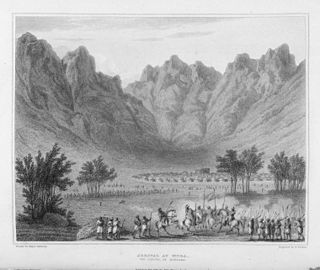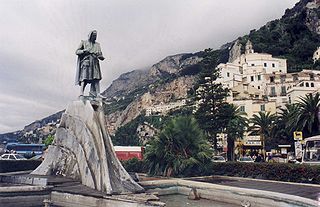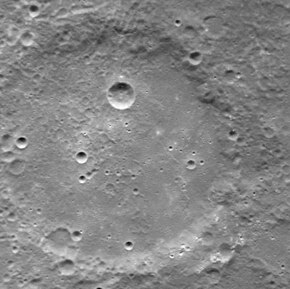
Oberon, also designated Uranus IV, is the outermost and second-largest major moon of the planet Uranus. It is the second-most massive of the Uranian moons, and the tenth-most massive moon in the Solar System. Discovered by William Herschel in 1787, Oberon is named after the mythical king of the fairies who appears as a character in Shakespeare's A Midsummer Night's Dream. Its orbit lies partially outside Uranus's magnetosphere.

Tim Hortons Inc., commonly nicknamed Tim's, Timmies, or Timmy's, is a multinational coffeehouse and restaurant chain based in Canada with headquarters in Toronto; it serves coffee, donuts, sandwiches, and other fast-food items. It is Canada's largest quick-service restaurant chain, with 5,701 restaurants in 13 countries, as of September 2023.

Mimas, also designated Saturn I, is the seventh-largest natural satellite of Saturn. With a mean diameter of 396.4 kilometres or 246.3 miles, Mimas is the smallest astronomical body known to be roughly rounded in shape due to its own gravity. Mimas's low density, 1.15 g/cm3, indicates that it is composed mostly of water ice with only a small amount of rock, and study of Mimas's motion suggests that it may have a liquid ocean beneath its surface ice. The surface of Mimas is heavily cratered and shows little signs of recent geological activity. A notable feature of Mimas's surface is Herschel, one of the largest craters relative to the size of the parent body in the Solar System. Herschel measures 139 kilometres across, about one-third of Mimas's mean diameter, and formed from an extremely energetic impact event. The crater's name is derived from the discoverer of Mimas, William Herschel, in 1789. The moon's presence has created one of the largest 'gaps' in Saturn's ring, named the Cassini Division, due to orbital resonance destabilizing the particles' orbit there.

The Second Intermediate Period dates from 1700 to 1550 BC. It marks a period when ancient Egypt was divided into smaller dynasties for a second time, between the end of the Middle Kingdom and the start of the New Kingdom. The concept of a Second Intermediate Period generally includes the 13th through to the 17th dynasties, however there is no universal agreement in Egyptology about how to define the period.

Surgeon-Major James Africanus Beale Horton was a British Army officer, surgeon, writer and banker. Born in Gloucester, Sierra Leone into a Creole family who were liberated from enslavement by the Royal Navy, he began attending the SLGS in 1845. After graduating from Fourah Bay College, Horton received a War Office scholarship study medicine in Britain to prepare him for a career in the British Armed Forces, and he attended King's College London and the University of Edinburgh. Serving in the West India Regiments, Horton was posted to various locations within the British Empire, including Lagos, the Gambia, Sierra Leone and the Gold Coast and participated in the Anglo-Ashanti wars.

Shackleton is an impact crater that lies at the lunar south pole. The peaks along the crater's rim are exposed to almost continual sunlight, while the interior is perpetually in shadow. The low-temperature interior of this crater functions as a cold trap that may capture and freeze volatiles shed during comet impacts on the Moon. Measurements by the Lunar Prospector spacecraft showed higher than normal amounts of hydrogen within the crater, which may indicate the presence of water ice. The crater is named after Antarctic explorer Ernest Shackleton.

Fabry is a large lunar impact crater of the form termed a walled plain. It is located on the far side of the Moon, just beyond the northeastern limb. Parts of this area are sometimes brought into view by the effects of libration, but the terrain is seen from the edge and so not much in the way of detail can be observed.

Oualata or Walata is a small oasis town in southeast Mauritania, located at the eastern end of the Aoukar basin. Oualata was important as a caravan city in the thirteenth and fourteenth centuries as the southern terminus of a trans-Saharan trade route and now it is a World Heritage Site.

Chevallier is a lunar impact crater that is located in the northeastern part of the Moon's near side, about a crater diameter east-southeast of the prominent crater Atlas. To the south-southeast of Chevallier is the flooded crater Shuckburgh. Chevallier was named by the IAU in 1935.

Espin is a lunar impact crater that lies on the far side of the Moon, just beyond the northeastern limb. It lies to the west-southwest of the larger crater Seyfert, and northwest of Deutsch.

Amyrtaeusof Sais is the only pharaoh of the Twenty-eighth Dynasty of Egypt and is thought to be related to the royal family of the Twenty-sixth Dynasty. He ended the first Persian occupation of Egypt and reigned from 404 BC to 399 BC. Amyrtaeus' successful insurrection inaugurated Egypt's last significant phase of independence under native sovereigns, which lasted for about 60 years until the Persians conquered the country again.

The Mandara Kingdom was an African kingdom in the Mandara Mountains of what is today Cameroon. The Mandara people are descended from the kingdom's inhabitants.

Flavio Gioia or Gioja, also known as Ioannes Gira Amalphensis is reputed to have been an Italian mariner, inventor, and supposedly a marine pilot. He has traditionally been credited with developing the sailor's compass, but this has been debated. However, he is credited with perfecting it by suspending its needle over a wind rose design with north designed by a fleur-de-lys, and enclosing it in a box with a glass cover. He was also said to have introduced such design, which pointed North, to defend against Charles of Anjou, the French king of Naples.

Tooting is an impact crater with volcanic features at 23.1°N, 207.1°E, in Amazonis Planitia, due west of the volcano Olympus Mons, on Mars. It was identified by planetary geologist Peter Mouginis-Mark in September 2004. Scientists estimate that its age is on the order of hundreds of thousands of years, which is relatively young for a Martian crater. A later study confirms this order of magnitude estimate. A preliminary paper describing the geology and geometry of Tooting was published in 2007 by the journal Meteoritics and Planetary Science, vol. 42, pages 1615–1625. Further papers have been published, including a 2010 analysis of flows on the walls of Tooting crater by A. R. Morris et al., and a 2012 review paper by P.J. Mouginis-Mark and J.M. Boyce in Chemie der Erde Geochemistry, vol. 72, p. 1–23. A geologic map has also been submitted in 2012 to the U.S. Geological Survey for consideration and future publication.
Christopher Fyfe was a Scottish historian most noted for his work on Sierra Leone in West Africa.

Raden Saleh is a crater on Mercury. Its name was approved by the IAU in 2008, and it is named after a famous Indonesian painter named Raden Saleh.
William Broughton Davies was a Sierra Leonean Creole medical doctor who served in the British Colonial Army from 1860 to 1881. Davies was the first West African to qualify as a medical doctor in 1859.

Andal is a crater on Mercury. Its name was adopted by the International Astronomical Union in 1976. Andal is named for the Tamil writer Andal, who lived in the 10th century.

The Twenty-sixth Dynasty of Egypt was the last native dynasty of ancient Egypt before the Persian conquest in 525 BC. The dynasty's reign is also called the Saite Period after the city of Sais, where its pharaohs had their capital, and marks the beginning of the Late Period of ancient Egypt.
Restaurant Brands International Inc. (RBI) is a Canadian-American multinational fast food holding company. It was formed in 2014 by the $12.5 billion merger between American fast food restaurant chain Burger King and Canadian coffee shop and restaurant chain Tim Hortons, and expanded by the 2017 purchase of American fast-food chain Popeyes. The company is the fifth-largest operator of fast food restaurants in the world behind Subway, McDonald's Corporation, Starbucks and Yum! Brands. They are based alongside Tim Hortons in Toronto. For tax purposes, Burger King and Popeyes retain their existing operations and headquarters, both in Miami. The 2014 merger focused primarily on expanding the international reach of the Tim Hortons brand and providing financial efficiencies for both companies.


















